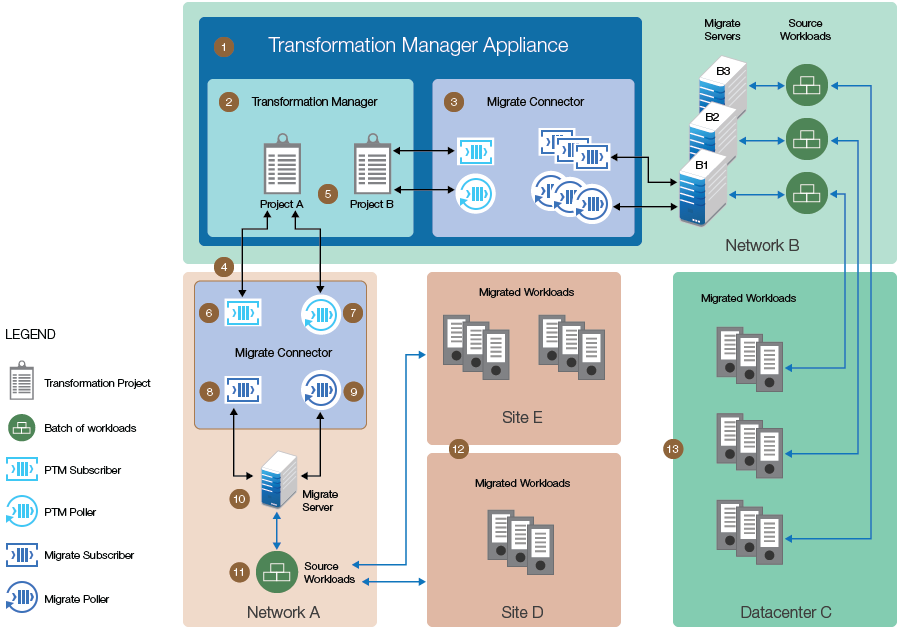1.1 PlateSpin Migration Factory Environment
The PlateSpin Migration Factory environment enables you to automate many tasks for workload migration by combining PlateSpin Transformation Manager with PlateSpin Migrate Connector and one or more PlateSpin Migrate servers. You can plan and execute automated migrations of workloads to target VMs on VMware Cluster hosts.
The transformation workflow and schedule determine when migration tasks are executed. Transformation Manager can pause automation to allow the Migration Specialist to manually perform some tasks. Migration Specialists can monitor the workload migrations and respond to exceptions, which enables them to handle more migrations in less time.
PlateSpin Migrate Connector integrates activities between Transformation Manager and Migrate servers. It load-balances the migration jobs across large farms of PlateSpin Migrate servers in the project. The Connector listens for migration events from Transformation Manager and delivers commands to the appropriate Migrate servers. The Connector listens for migration status events from the various PlateSpin Migrate servers and delivers event information only to the appropriate project and workload.
Figure 1-1 illustrates the deployment environment for automated PlateSpin migration. See Table 1-1 for a description of how automated migration works in a PlateSpin Migration Factory environment.
Figure 1-1 PlateSpin Migration Factory environment

Table 1-1 How Automated Migration Works in a PlateSpin Migration Factory Environment
|
PlateSpin Migration Factory environment |
Description |
|---|---|
|
The appliance VM hosts the PlateSpin Transformation Manager Server (PTM Server) and an instance of the Migrate Connector. |
|
A single PTM Server manages one or more Migrate Connector instances. |
|
The Migrate Connector instance on the Appliance is preconfigured to work with the PTM Server. This instance can integrate events for one or more Migrate servers in the same network as the Appliance. |
|
For multiple projects, you need a Migrate Connector instance in the same network as the PlateSpin Migrate servers and the source workloads to be migrated. Install the Connector on your own servers running SUSE Linux Enterprise Server (SLES) 11 SP4. |
|
With multiple projects, each Migrate Connector instance works with a single configurable project. The Connector ensures the privacy and security of each project’s data in a multi-tenant environment. |
|
Each Connector has one PTM Subscriber. The subscriber listens for events pushed from its assigned PTM Server. After you assign the Connector to a project, the subscriber listens only for events for that project. |
|
Each Connector has one PTM Poller. The poller periodically polls its assigned PTM Server to check that it has received all events since the last poll. After you assign the Connector to a project, the poller checks only for events for that project. |
|
Each Connector uses a separate Migrate Subscriber for each Migrate server assigned to its projects. Each subscriber listens for events pushed dynamically from its Migrate server. After you assign the Connector to a project, the subscribers listen only for events for that project. |
|
Each Connector uses a separate Migrate Poller for each Migrate server assigned to its projects. Each poller periodically polls its Migrate server to check that it has received all events since the last poll. After you assign the Connector to a project, the pollers check only for events for that project. |
|
For a project, you create a Migration Server resource for each PlateSpin Migrate server that you will use to execute workload migrations. When migration jobs begin, the Connector initiates a subscriber and poller for the specified Migrate server and starts listening and polling for migration state events. |
|
For a project, you import basic information about the source workloads that you plan to migrate, then an automated discovery process adds the details. For automated migrations, you can manually assign a specific Migration Server resource to a source workload, or you can allow the Connector to auto-assign a Migration Server resource. Auto-assignment ensures that workload migrations are load-balanced across all of the assigned Migrate servers. After you submit a workload, the migration workflow progresses according to the workload’s transformation plan through the Migrate server. |
|
Each workload’s transformation plan defines the proposed workload and its target VMware cluster and network. You organize the workload migrations into waves and batches, and schedule them according to your business needs. In this example, you plan to migrate workloads to multiple sites in the same or different network. Workloads in a batch have the same destination site. The Migration Specialist at each site manages the migrations to the site. |
|
In this example, you plan to migrate workloads to different VMware clusters in a data center. Workloads in a batch have the same destination VMware cluster. The Migration Specialist responsible for the target VMware cluster manages the migrations to that cluster. |
For deployment information, see Section 3.1, Deployment Requirements
.